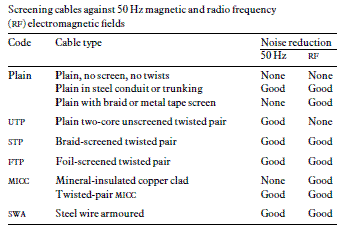- This topic has 1 reply, 1 voice, and was last updated 2 years, 11 months ago by .
-
Topic
-
In low voltage(110/220/400V)wiring in buildings what is the minimum separation between and maximum length of power,telephone,data,fire,PA wires if run in parallel if done in non metallic conduit?…
In low voltage(110/220/400V)wiring in buildings what is the minimum separation between and maximum length of power,telephone,data,fire,PA wires if run in parallel if done in non metallic conduit? What are those values if wiring is done in steel conduit or mineral insulated copper sheathed cables? Will there be any effect if cables of different services cross each other in which case what should be the clearances?
Viewing 1 replies (of 1 total)
Viewing 1 replies (of 1 total)
- You must be logged in to reply to this topic.

 In practice, a low cost, foil-screened twisted pair cable is suitable for most BMS applications for frequencies below 1 MHz. For IT and data communication circuits operating at frequencies above 1 MHz, such as Ethernet, the cable type will normally be specified by the equipment supplier. It may be coaxial cable or suitable twisted pair. The use of coaxial cable is not recommended for low frequency use as noise induced in the screen will be added to the signal. BMS signal cables should be kept as far away as practicable from sources of interference. In particular, untwisted cables should not be exposed to magnetic fields from high current equipment such as transformers. The IEE Wiring Regulations permit signal and power cables to share the same conduit, providing the signal cable has adequate insulation. The regulations are written from the point of view of electrical safety, and do not concern interference. Sharing a conduit or trunking makes for economical installation and some field bus systems, e.g. EIBus, are designed so that this will not introduce any EMC problems. However, in general it is recommended that signal cables without screening should be separated from power cables by a minimum distance of 150 mm. Ideally signal and power cables should be routed in separate trays or trunking, and cross at right angles where they meet. Table below presents general recommendations for different types of screened signal and power cables; manufacturers
In practice, a low cost, foil-screened twisted pair cable is suitable for most BMS applications for frequencies below 1 MHz. For IT and data communication circuits operating at frequencies above 1 MHz, such as Ethernet, the cable type will normally be specified by the equipment supplier. It may be coaxial cable or suitable twisted pair. The use of coaxial cable is not recommended for low frequency use as noise induced in the screen will be added to the signal. BMS signal cables should be kept as far away as practicable from sources of interference. In particular, untwisted cables should not be exposed to magnetic fields from high current equipment such as transformers. The IEE Wiring Regulations permit signal and power cables to share the same conduit, providing the signal cable has adequate insulation. The regulations are written from the point of view of electrical safety, and do not concern interference. Sharing a conduit or trunking makes for economical installation and some field bus systems, e.g. EIBus, are designed so that this will not introduce any EMC problems. However, in general it is recommended that signal cables without screening should be separated from power cables by a minimum distance of 150 mm. Ideally signal and power cables should be routed in separate trays or trunking, and cross at right angles where they meet. Table below presents general recommendations for different types of screened signal and power cables; manufacturers